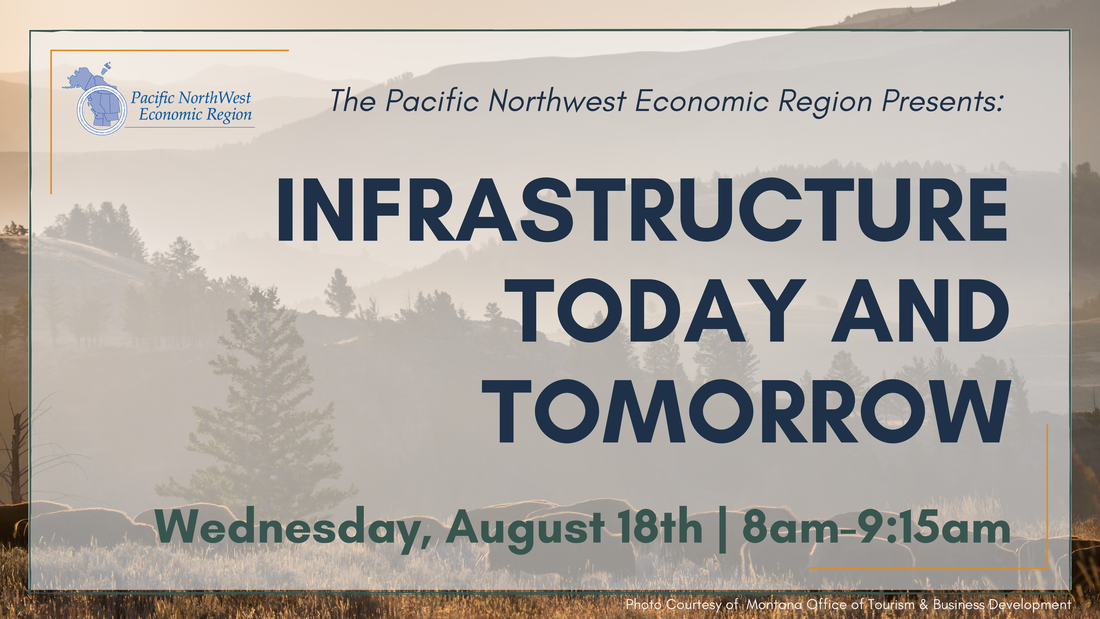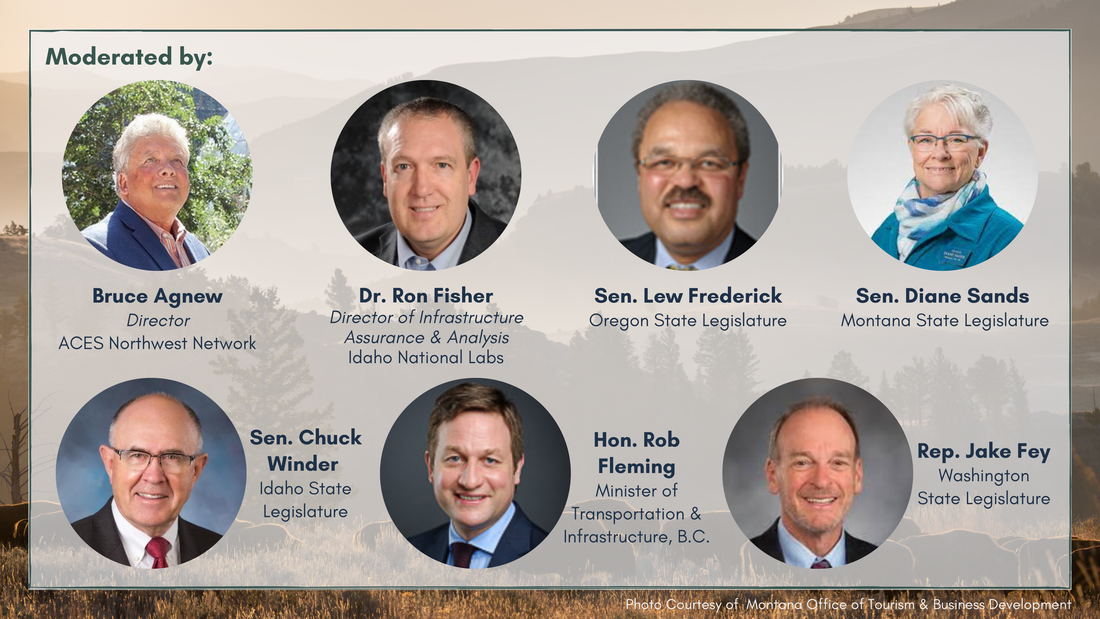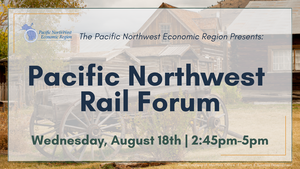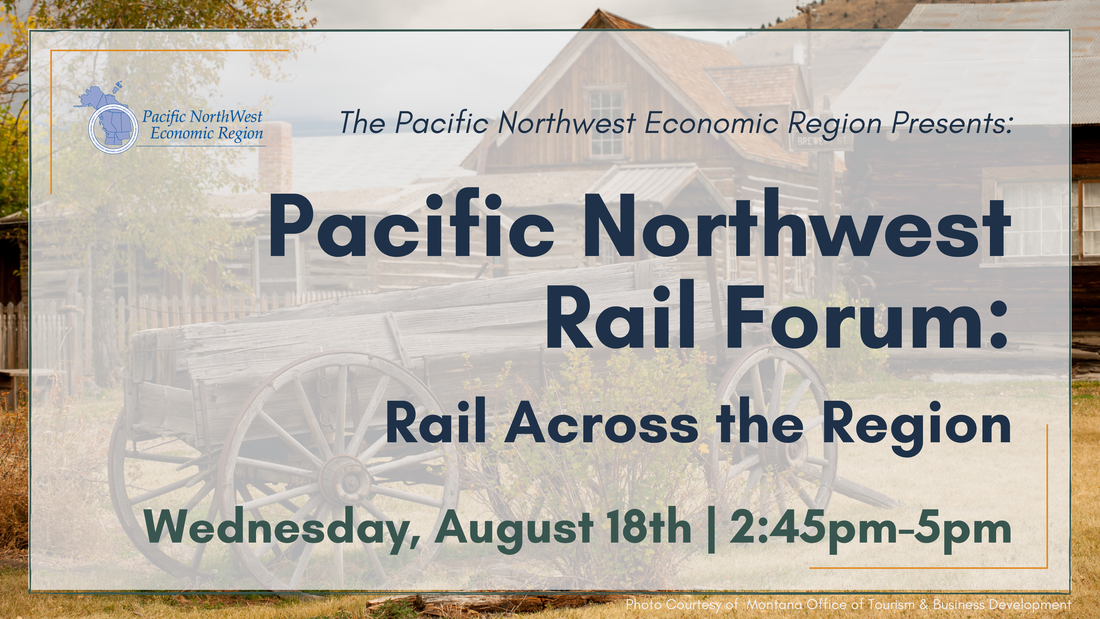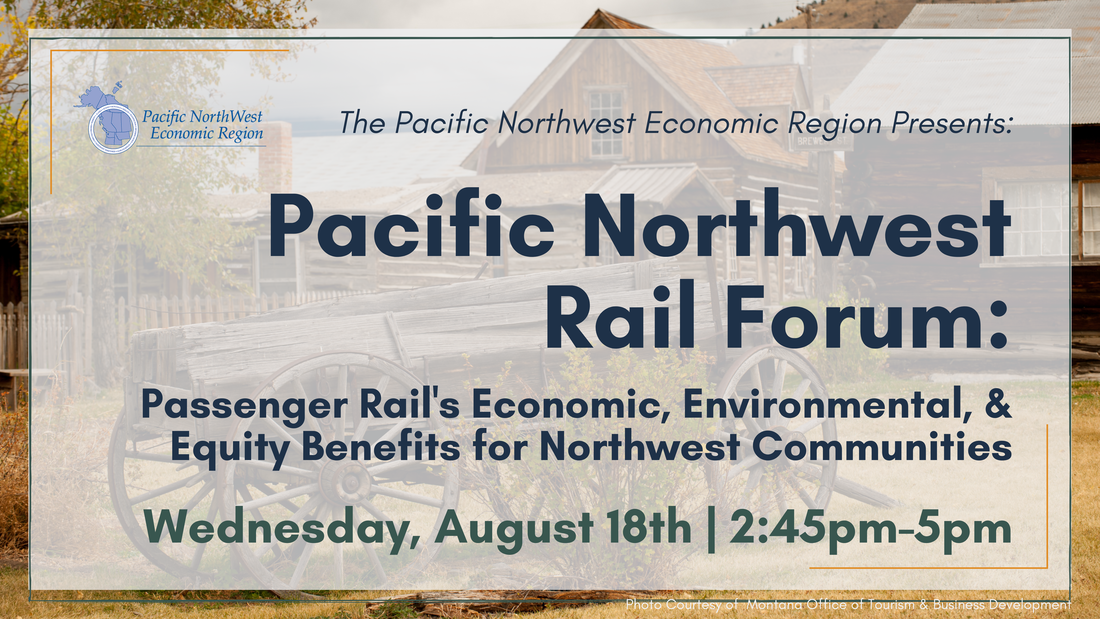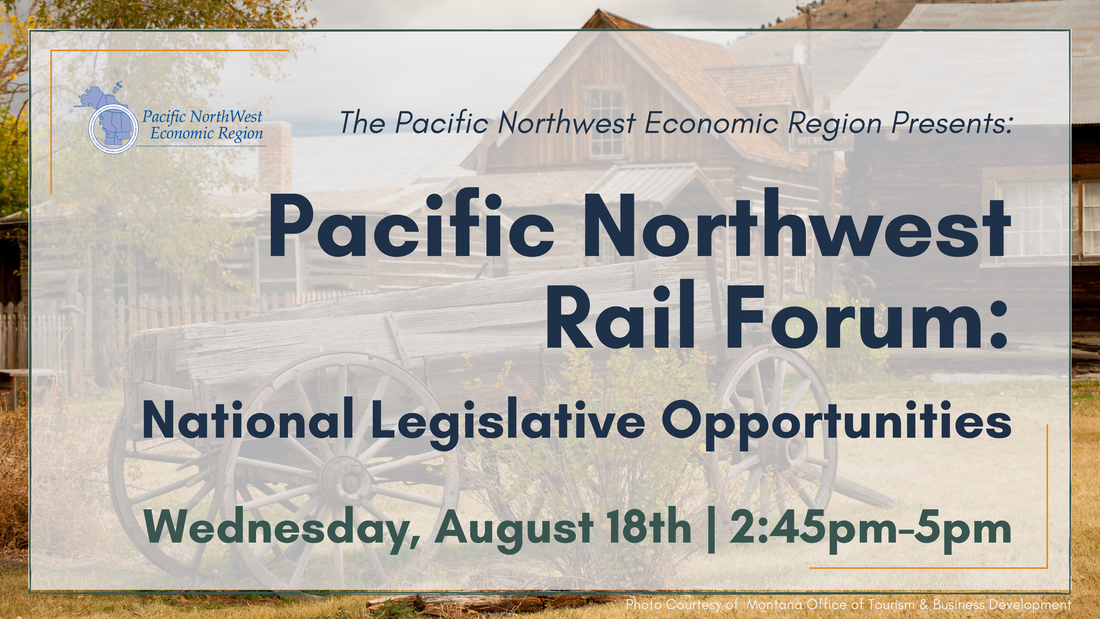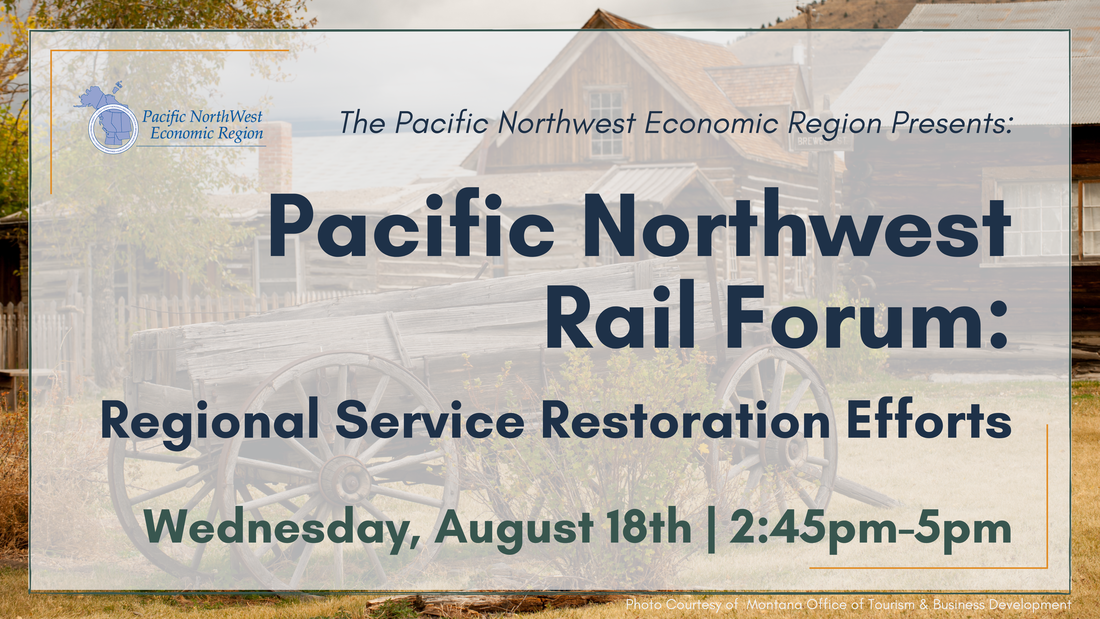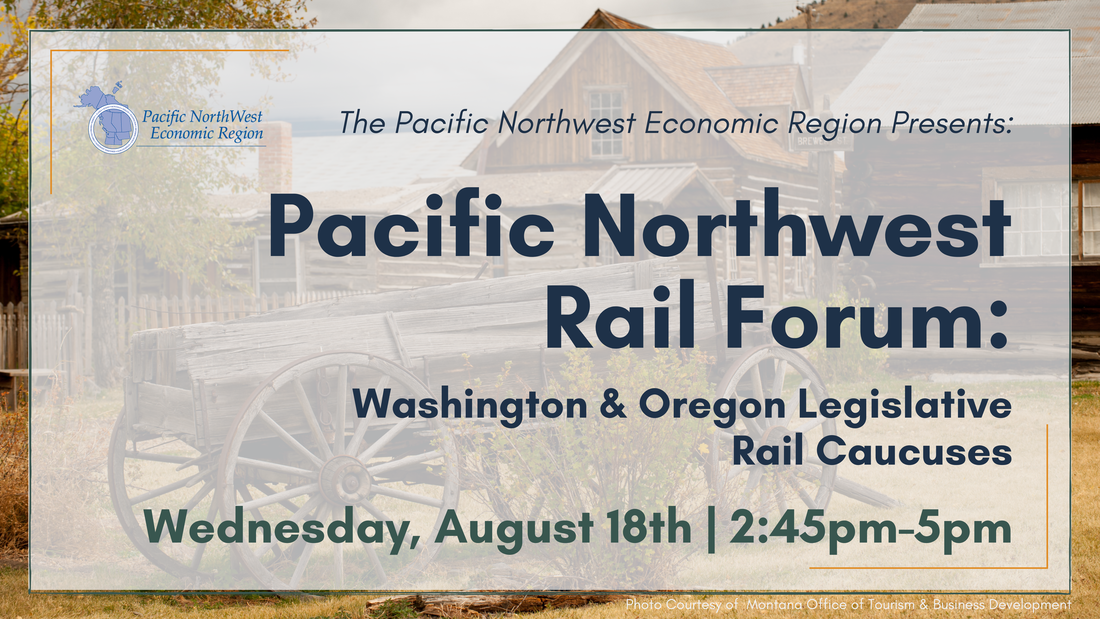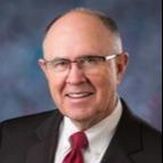PNWER at Work > Working Groups > Transportation
|
About Recent Events Resources
Oil by Rail Autonomous Vehicles Leadership Contact Staff |
AboutPNWER's Transportation working group focuses on the infrastructure of our major corridors and gateways, with a special interest on border infrastructure.
The Pacific NorthWest Economic Region (PNWER) was 1 of 5 recipients from across the U.S. selected for the Department of Transportation Build America Bureau’s Regional Infrastructure Accelerator (RIA) program. PNWER will use grant funds to establish a Regional Infrastructure Accelerator to serve as a convener for transportation projects in the region, specifically multistate and multi-jurisdictional initiatives that are needed but lack funding for completion. Learn more about the PNWER RIA program here! Major focus areas of this group include:
The Transportation working group is also closely linked to the Infrastructure Finance working group. Please click here for more information. |
Recent and Current Events
PNWER has collaborated with our partners at ACES Northwest Network to present to the Washington State Transportation Commission on a variety of issues, including the Future of Logistics on Tuesday, October 19 from 9 am - 12 pm Pacific. You can watch the recording of that session here.
2021 PNWER Annual Summit - Transportation, Infrastructure, & Rail
During PNWER's 30th Annual Summit, hosted as a hybrid event in Big Sky, Montana, the Transportation and Infrastructure working groups organized exciting programming on various critical T&I related topics. In collaboration with All Aboard Washington and Big Sky Passenger Rail Authority, PNWER hosted a Pacific Northwest Rail Forum, where experts and community members from the region discussed the present state and future of rail, and how the region can leverage existing systems to stay a competitive and green region.
Session 13: Infrastructure Today and Tomorrow
Wednesday, August 18 | 8:00-9:15am MT
Wednesday, August 18 | 8:00-9:15am MT
Transportation and Infrastructure have emerged as priority issues in both the U.S. and Canada. Hear from key transportation legislators from across PNWER as they discuss recent transportation successes, and what is on the legislative agenda for upcoming sessions.
Sponsored by BNSF Railway
Session 14: Safer, Faster, Cleaner- The Future of Freight Mobility
Wednesday, August 18 | 9:30-10:30am MT
Wednesday, August 18 | 9:30-10:30am MT
Autonomous and electrified transportation is coming to freight vehicles and aircraft much more quickly than it is to the general public. The incorporation of autonomous Level 3, 4, and 5 technology has the potential to make trucking safer and more efficient, while preserving jobs and keeping drivers closer to home.
The past year has seen both stronger corporate climate promises, and a new federal push towards electrification of transportation. Explore what the Pacific Northwest has been doing to lead the nation - in the US and Canada - on electrification initiatives and effective strategies for this transition to increasingly electric and autonomous vehicles and aircraft.
The past year has seen both stronger corporate climate promises, and a new federal push towards electrification of transportation. Explore what the Pacific Northwest has been doing to lead the nation - in the US and Canada - on electrification initiatives and effective strategies for this transition to increasingly electric and autonomous vehicles and aircraft.
Session 18: Pacific Northwest Rail Forum
Wednesday, August 18 | 2:45-5:15pm
Wednesday, August 18 | 2:45-5:15pm
|
Rail crosses and unites the PNWER region, serving as a gateway for goods to move from interior states and communities, delivering them to Pacific ports and global markets. Trains can also provide an accessible, low-carbon way to travel across the U.S., but is vastly under-utilized by passengers. In this joint session hosted by All Aboard Washington, hear from experts around the region on the present state and future of rail, and how we can leverage our existing systems to stay a competitive and green region.
|
Sponsored by All Aboard Washington and Big Sky Passenger Rail Authority
Future of Flight: Reimagining Sustainable Air Travel Post-COVID
For our 2020 Economic Leadership Forum, PNWER partnered with the South Island Prosperity Partnership (SIPP) to host sessions on the future of economic recovery within the PNW region. For speaker bios, presentation slides, white papers, etc. please click here.
Resources
Action Items & Findings
2019 Action Items - Transportation & Infrastructure |
Write letter of support from PNWER urging the U.S. to issue a Presidential Permit for Alaska to Alberta (A2A) project. |
Hold legislative panel in Big Sky 2020 on ACES, 5G connected technologies, harmonizing regulations, Smart cities, includes Smart communities focusing on rural development through 5G and other technologies to maintain economic prosperity |
Support requests to U.S. DOT to assist with $25 million to continue maintenance of Alaska-Canada highway that goes through Yukon and B.C. |
2019 Findings - Transportation & Infrastructure |
It was noted that the Transportation working group should collaborate with the Border working group; Cascadia Innovation Corridor; and state, provincial, and federal agencies to promote the testing of autonomous vehicles (personal and commercial) on the I-5 and Hwy 99 corridor. |
Idaho DOT will continue to be a leader on harmonizing trucking regulations among 5 NW states and showcase similar improvements in Western Canada provinces. |
Summit Archive
Summer 2019
Action Items
Presentations
Summer 2018
Agenda
Summer 2017
Action Items
Summer 2016
Action Items
Agenda
Presentations
Summer 2015
Action Items
Proceedings
Agenda
Presentations
Summer 2014
Transportation I Proceedings
Transportation II Proceedings
Transportation Action Items
Presentations
Action Items
Presentations
Summer 2018
Agenda
Summer 2017
Action Items
Summer 2016
Action Items
Agenda
Presentations
Summer 2015
Action Items
Proceedings
Agenda
Presentations
Summer 2014
Transportation I Proceedings
Transportation II Proceedings
Transportation Action Items
Presentations
Presentations
Presentations from the 2019 PNWER Annual Summit in Saskatoon
News & Links
News
Links
- Transportation technology can deliver us from viaduct-closure gridlock - Seattle Times, Jan. 7 2019
- Harbour Air to add zero-emission electric plane; aims to convert whole fleet - Times Colonist, March 2019
- Seaplane flights connecting Seattle and Vancouver to start April 26; Microsoft cheers 'important link' - GeekWire, 4/5/18
Links
Summit Agenda
-
2019 Summit - Saskatoon
-
2018 Summit - Spokane
-
2017 Summit - Portland
<
>
Welcome and Overview of Innovative Infrastructure Finance Taskforce
Investing in American and Canadian infrastructure from public and private resources has rarely been higher on the political agenda of the two countries as it is today. PNWER is seeking to expand the public private partnership initiative through a federally sanctioned regional accelerator. This session will explore the latest developments in Washington D.C. and local and private sector responses.
The federal government and PNWER regional accelerator:
Session will examine fast tracking public-private partnerships (P3’s) and existing federal credit and loan programs (Transportation Infrastructure Finance and Innovation Act (TIFIA) and Railroad Rehabilitation and Improvement Financing (RRIF). The Trump Administration proposes to replace the FASTLANE program with the $1.5 billion INFRA program.
Can P3s enhance project delivery and permit reform? Why do we need them in limited resource and lower expertise environments? What purpose do they serve for urban regions (Vancouver B.C., Seattle- Tacoma, Portland) and rural regions (Port of Everett, Washington and Kalispell, Montana)?
Moderated by Leslie Blakely, President, Coalition for America’s Gateways and Trade Corridors
Federal Government
State and local government response: designing state and local initiatives to leverage federal infrastructure initiatives
Columbia River I-5 Bridge Replacement Project
University Partnerships and Applied Research
Canada accelerates P3s; opportunities for Northwest states
Canada is recognized as the global leader in building effective P3’s with more than 250 projects with a total capital value of over $120 billion. Between 2003 and 2012, P3 projects in Canada generated $15 billion in direct GDP, nearly 300,000 in direct, full-time equivalent jobs, and $7.5 billion in direct tax revenue to governments across Canada.
Performance-based Infrastructure on the West Coast
Moderated by Mark Romoff of the Canadian Council for Public Private Partnerships
Successful Leadership in Private-Public Partnerships
Advancing the Cascadia Innovation Corridor and Enhancing Cross-Border Connections
Investing in American and Canadian infrastructure from public and private resources has rarely been higher on the political agenda of the two countries as it is today. PNWER is seeking to expand the public private partnership initiative through a federally sanctioned regional accelerator. This session will explore the latest developments in Washington D.C. and local and private sector responses.
The federal government and PNWER regional accelerator:
Session will examine fast tracking public-private partnerships (P3’s) and existing federal credit and loan programs (Transportation Infrastructure Finance and Innovation Act (TIFIA) and Railroad Rehabilitation and Improvement Financing (RRIF). The Trump Administration proposes to replace the FASTLANE program with the $1.5 billion INFRA program.
Can P3s enhance project delivery and permit reform? Why do we need them in limited resource and lower expertise environments? What purpose do they serve for urban regions (Vancouver B.C., Seattle- Tacoma, Portland) and rural regions (Port of Everett, Washington and Kalispell, Montana)?
Moderated by Leslie Blakely, President, Coalition for America’s Gateways and Trade Corridors
Federal Government
- Shawn Bills, State Director, Office of U.S. Senator Patty Murray, Washington
- Ree Armitage, Field Liaison, Office of U.S. Senator Ron Wyden, Oregon
State and local government response: designing state and local initiatives to leverage federal infrastructure initiatives
- Tobias Read, Treasurer, State of Oregon
- Justin Ashford, Principal Consultant, Advisory Services, WSP USA
- Michael Catsi, Director, Business Development and Communications, Alaska Industrial Development and Export Authority
- Jeannie Beckett, The Beckett Group
Columbia River I-5 Bridge Replacement Project
- Rep. Sharon Wylie, Washington State Legislature
University Partnerships and Applied Research
- Ahmed Elayouty, Co-founder, Pacific Hyperloop, University of Washington
Canada accelerates P3s; opportunities for Northwest states
Canada is recognized as the global leader in building effective P3’s with more than 250 projects with a total capital value of over $120 billion. Between 2003 and 2012, P3 projects in Canada generated $15 billion in direct GDP, nearly 300,000 in direct, full-time equivalent jobs, and $7.5 billion in direct tax revenue to governments across Canada.
- Mark Romoff, President and CEO, Canadian Council for Public Private Partnerships
Performance-based Infrastructure on the West Coast
Moderated by Mark Romoff of the Canadian Council for Public Private Partnerships
- Scott Boardman, Acting Executive Director, West Coast Infrastructure Exchange
- Anthony Buckley, Director, Innovative Partnerships, Washington State Department of Transportation
Successful Leadership in Private-Public Partnerships
- Mass Transit: Canada Line serving downtown Vancouver and Vancouver International Airport
- Jussi Jaakkola, Vice President, Investment Development, SNC-Lavalin
Advancing the Cascadia Innovation Corridor and Enhancing Cross-Border Connections
- High Speed Rail in the Pacific Northwest
- Charles Knutson, Senior Policy Advisor, Transportation and Economic Development, Office of Governor Inslee
Webinars & Resources
Cutting the Red Tape: Permit Modernization
July 15, 2020
Watch the Recording Here
Click Here for Presentation Slides
State Permitting Council Handout
About FAST-41 & FPISC Handout
The permitting process for infrastructure projects across the United States is dated and often redundant, causing expensive delays before projects are even cleared to begin construction. In the U.S., the Federal Permitting Improvement Steering Council (FPISC) seeks to streamline this federal permitting process without changing existing regulations, applying a 21st century program management approach to qualifying federal projects. Canada was successfully able to streamline federal and provincial permitting to complete the Asia Pacific Gateway project in the mid-2000’s, and has valuable best practices that can be implemented in the U.S. From a labor perspective, permit modernization and streamlining - without changing the substance of environmental regulations or other laws - could help support local job markets, especially following the COVID-19 related economic downturn. Following expert presentations, state legislators from Alaska, Idaho, and Washington discussed how a state-level permit streamlining council, similar to the FPISC, could help local infrastructure projects.
Moderated by PNWER Transportation Co-Chairs Bruce Agnew and Chuck Winder, featured speakers include:
July 15, 2020
Watch the Recording Here
Click Here for Presentation Slides
State Permitting Council Handout
About FAST-41 & FPISC Handout
The permitting process for infrastructure projects across the United States is dated and often redundant, causing expensive delays before projects are even cleared to begin construction. In the U.S., the Federal Permitting Improvement Steering Council (FPISC) seeks to streamline this federal permitting process without changing existing regulations, applying a 21st century program management approach to qualifying federal projects. Canada was successfully able to streamline federal and provincial permitting to complete the Asia Pacific Gateway project in the mid-2000’s, and has valuable best practices that can be implemented in the U.S. From a labor perspective, permit modernization and streamlining - without changing the substance of environmental regulations or other laws - could help support local job markets, especially following the COVID-19 related economic downturn. Following expert presentations, state legislators from Alaska, Idaho, and Washington discussed how a state-level permit streamlining council, similar to the FPISC, could help local infrastructure projects.
Moderated by PNWER Transportation Co-Chairs Bruce Agnew and Chuck Winder, featured speakers include:
- Alex Herrgott, FPISC Executive Director
- John Higginbotham, Former Assistant Deputy Minister (2005-10), Transport Canada
- Mike Bridges, President of Longview / Kelso Building Council and Business Representative for IBEW Local 48
- Senator Shelley Hughes, AK
- Senator Chuck Winder, ID
- Representative Jake Fey, WA
Road & Rail: Safety in Separation
June 4, 2020
Watch the Recording Here
Click Here for Presentation Slides
Click Here for Background Resources
Rail transit is an essential part of the transportation of consumer goods across North America. However, the areas where railroads intersect with highway systems cause congestion, delays, and present significant safety risks. With the potential for a major Congressional infrastructure bill on the horizon, federal highway-rail grade separation must be prioritized to improve safety and efficiency of the United State's infrastructure. How can federal, state, and local governments work with railroads and community stakeholders to implement high-cost grade separation projects to improve community safety and increase efficiency?
Moderated by Bruce Agnew and Chuck Winder, featured speakers include:
June 4, 2020
Watch the Recording Here
Click Here for Presentation Slides
Click Here for Background Resources
Rail transit is an essential part of the transportation of consumer goods across North America. However, the areas where railroads intersect with highway systems cause congestion, delays, and present significant safety risks. With the potential for a major Congressional infrastructure bill on the horizon, federal highway-rail grade separation must be prioritized to improve safety and efficiency of the United State's infrastructure. How can federal, state, and local governments work with railroads and community stakeholders to implement high-cost grade separation projects to improve community safety and increase efficiency?
Moderated by Bruce Agnew and Chuck Winder, featured speakers include:
- Representative Rick Larsen (WA), U.S. House of Representatives
- Andrew Johnson, Consultant, Former 15-year Assistant VP, BNSF Railway
- James Healy, DuPage County Board Member, Chairman of the National Highway Committee for the National Association of Counties (NACo)
- Paul Cristina, Director of Public Projects & System Design, BNSF Railway
- Devan Fitch, Director - Infrastructure Delivery, Vancouver Fraser Port Authority
Harbour to Harbor
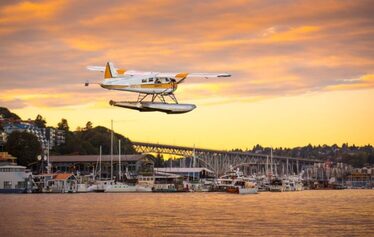
PNWER has long supported “Harbour to Harbor” seaplane service between Vancouver, British Columbia and Seattle, Washington. British Columbia and Washington state share significant economic and cultural ties including the remarkably successful Two Nation Vacation initiative that has attracted international visitors and accelerated joint infrastructure and high technology investments.
“Harbour to Harbor” is an important addition to the rich mix of highway, rail, ferry, cruise ship, seaplane and fixed wing aircraft transportation operations that uniquely defines our bi-national region. Vancouver and Seattle share similar innovative, risk-taking cultures and a one hour “Harbour to Harbor” seaplane connection will accelerate the “Cascadia Innovative Corridor” initiative launched by Microsoft and others that has expanded cross-border employment and attracted world wide talent to the region.
Our regional border security agency leaders also have a well-deserved reputation for cross border cooperation and effectiveness in partnering with private sector transportation providers in deploying innovative, technology based procedures for enhanced security. “Harbour to Harbor” seaplane service affords Transport Canada and the Canada Border Services Agency a new and exciting venue to continue to showcase Canada’s innovative approach.
Additional resources and information can be found on the Tourism working group page here.
“Harbour to Harbor” is an important addition to the rich mix of highway, rail, ferry, cruise ship, seaplane and fixed wing aircraft transportation operations that uniquely defines our bi-national region. Vancouver and Seattle share similar innovative, risk-taking cultures and a one hour “Harbour to Harbor” seaplane connection will accelerate the “Cascadia Innovative Corridor” initiative launched by Microsoft and others that has expanded cross-border employment and attracted world wide talent to the region.
Our regional border security agency leaders also have a well-deserved reputation for cross border cooperation and effectiveness in partnering with private sector transportation providers in deploying innovative, technology based procedures for enhanced security. “Harbour to Harbor” seaplane service affords Transport Canada and the Canada Border Services Agency a new and exciting venue to continue to showcase Canada’s innovative approach.
Additional resources and information can be found on the Tourism working group page here.
Oil By Rail
Since 2012, the transportation of crude oil by freight rail has been rapidly increasing in Washington and other states in the Pacific Northwest. The spate of recent derailments in Canada and the U.S. has led to new regulations in oil train operations and tank car construction, along with an increased local desire for transparency and accountability in regards to oil train routing and scheduling. In order to address these issues, the Center for Regional Disaster Resilience has begun to explore oil freight rail transportation and safety as part of its Program Areas.
Pacific Northwest Economic Region (PNWER) and the Center for Regional Disaster Resilience (CRDR) hosted an Oil Train Safety Symposium at Clover Park Technical College in Lakewood, Washington on April 27, 2016. The Transportation Working Group, co-chaired by Sen. Chuck Winder, Idaho, and Bruce Agnew, Director, Cascadia Center for Regional Development, has addressed oil by rail concerns at recent PNWER meetings.
This symposium provided a comprehensive overview of the current and future status of oil by rail transportation and emphasize partnerships to help ensure oil transport safety is being addressed across the region. By fostering dialogue between public and private sector entities, PNWER and CRDR hope to increase mutual understanding of oil train safety issues in a broad and holistic manner by including stakeholders from all parts of the supply chain both in the U.S. and Canada. The Symposium agenda is still under development; topics will include an overview of the transportation of hazardous material by rail, the driving factors behind the rise of oil transportation by rail, potential safety hazards, incident response, and planning for future movement of other fuel products.
Find the event report, presentation, and oil safety news here.
Pacific Northwest Economic Region (PNWER) and the Center for Regional Disaster Resilience (CRDR) hosted an Oil Train Safety Symposium at Clover Park Technical College in Lakewood, Washington on April 27, 2016. The Transportation Working Group, co-chaired by Sen. Chuck Winder, Idaho, and Bruce Agnew, Director, Cascadia Center for Regional Development, has addressed oil by rail concerns at recent PNWER meetings.
This symposium provided a comprehensive overview of the current and future status of oil by rail transportation and emphasize partnerships to help ensure oil transport safety is being addressed across the region. By fostering dialogue between public and private sector entities, PNWER and CRDR hope to increase mutual understanding of oil train safety issues in a broad and holistic manner by including stakeholders from all parts of the supply chain both in the U.S. and Canada. The Symposium agenda is still under development; topics will include an overview of the transportation of hazardous material by rail, the driving factors behind the rise of oil transportation by rail, potential safety hazards, incident response, and planning for future movement of other fuel products.
Find the event report, presentation, and oil safety news here.
Autonomous, Connected Electric Shared Vehicles
Transportation technology can deliver us from viaduct-closure gridlock - Seattle Times, Jan. 7 2019
Leadership
PNWER Staff
Banner photo by kidkutsmedia
|
World Trade Center West
2200 Alaskan Way, Suite 460 Seattle, WA 98121 |
|

